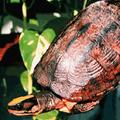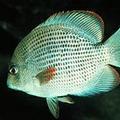 世界上所有淡水生態系統的生物多樣性第一次發展了全面性的物種圖譜並且建立了資料庫。在人口成長、水用途越趨多元以及棲地環境改變等壓力越來越大的情況下,這些新工具將有助於保育人士對於保護淡水生態系統的努力。
世界上所有淡水生態系統的生物多樣性第一次發展了全面性的物種圖譜並且建立了資料庫。在人口成長、水用途越趨多元以及棲地環境改變等壓力越來越大的情況下,這些新工具將有助於保育人士對於保護淡水生態系統的努力。
今天發行的「世界淡水生態區」是世界自然基金會(World Wildlife Fund)以及美國自然保育協會(Nature Conservancy)二大非營利組織之間的一項合作計畫,此二大組織可說是規模較大的國際網絡中的重要成員。
此物種圖譜和資料庫是由超過200位環境保育學家歷經10年努力與奉獻所得的工作成果。
世界自然基金會領導此研究的艾貝爾(Robin Abell)指出,「在對於自然世界的研究中,我們最少涉及的就是淡水生態系統,他們就像廣闊且尚未被開發的圖書館一樣,還擁有著豐富資訊有待探索。」
艾貝爾也表示,「不管是不是科學家,『世界淡水生態區』讓人們都能更了解這個世界,並且在各物種和系統消失之前幫助拯救牠們免於喪失。」
而這也是首次對於淡水物種進行編輯與匯整的研究,包括魚類、兩棲生物、鱷魚和烏龜等,幾乎是以位於世界內陸水域的棲地為主。
將近有18,000個物種被編入物種圖譜並納入淡水生態區,在這個物種表中包括了有13,400種魚類、4,000種兩棲生物、300種龜類以及20種鱷魚及其近親物種。
 比起周圍不同的生態區、甚至是來自同一個保育單位,在同一生態區之下的淡水物種、動態條件和環境條件都會比較類似。
比起周圍不同的生態區、甚至是來自同一個保育單位,在同一生態區之下的淡水物種、動態條件和環境條件都會比較類似。
而在這個以「世界淡水生態區」為名的物種圖譜和資料庫中,將世界的淡水系統分為426個不同的保育單位。
其中很多的保育單位有擁有很豐富的物種資源,但是也都處於壓力漸增的環境當中,農業、工業、飲水、家畜業等對於水資源的過度使用,讓淡水生態系統中的55個生態區面臨高度壓力,也危及各物種及棲地。
The diversity of life in all the world's freshwater ecosystems is for the first time displayed on a comprehensive map and held in a database. These new tools can be of use to conservationists who are trying to save freshwater ecosystems that are under increasing pressure from human population growth, rising water use, and habitat alteration.
Unveiled today, Freshwater Ecoregions of the World is a collaborative project between the World Wildlife Fund and the Nature Conservancy, two U.S. nonprofit organizations that are part of larger international networks.
The map and database are the result of 10 years of work and contributions by more than 200 conservation scientists.
"Freshwater ecosystems are the least studied parts of our natural world. They are like vast unexplored libraries, brimming with information," said World Wildlife Fund's Robin Abell, who headed the study.
"Freshwater Ecoregions of the World allows scientists and non-scientists alike to gain a better understanding of this world and help guide efforts to save these systems and species before they are lost," said Abell.
This is the first study to compile data on freshwater species - fish, amphibians, crocodiles and turtles - for nearly all of the world's inland water habitats.
Close to 18,000 species have been mapped and placed into freshwater ecoregions. This species list includes 13,400 fish, 4,000 amphibians, 300 turtles, and 20 crocodile species and their relatives.
The freshwater species, dynamics, and environmental conditions within a given ecoregion are more similar to each other than to those of surrounding ecoregions and together form a conservation unit.
The map and database, called "Freshwater Ecoregions of the World," divides the world's freshwater systems into 426 distinct conservation units.
Many of these units are rich in species but are under increasing pressure. Excessive water use for agriculture, industry, drinking and livestock are placing freshwater ecosystems in 55 ecoregions under high stress, threatening the species and habitats.
全文及圖片詳見:ENS





